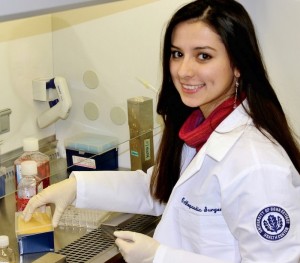In Vitro Evaluation of Calcium Peroxide Release from Composite Poly(lactic-co-glycolic acid) Microsphere Scaffolds
Fall 2013-Spring 2015
 Investigators: Ornella Tempo, Keshia Ashe, Yusuf Khan Ph.D, Cato Laurencin Ph.D/M.D UConn Health Center, Farmington CT
Investigators: Ornella Tempo, Keshia Ashe, Yusuf Khan Ph.D, Cato Laurencin Ph.D/M.D UConn Health Center, Farmington CT
Bone tissue engineering looks specifically at the intersection of cells, biomaterials, and bioactive factors for the restoration of normal bone function following instances of surgical, degenerative, or traumatic bone loss. The objective of this project was to investigate the potential of a materials-only based approach for guided bone regeneration. Specifically, the capabilities of composite poly(lactic-co-glycolic acid) (PLAGA) and calcium peroxide (CaO2) sintered microsphere scaffolds were investigated as an alternative to current bone repair strategies. During this project, composite sintered microspheres were fabricated, sintered into 3-dimensional (3D) matrices, and evaluated the in vitro release of CaO2.
Scaffold Fabrication: Composite PLAGA/CaO2 sintered scaffolds were fabricated using the single emulsion method. Briefly, calcium peroxide (Sigma Aldrich) was combined with 85:15 PLAGA (Lakeshore Biomaterials) in MeCl2 and added to a surfactant solution (1% PVA) at 4°C and pH 10. Following MeCl2 evaporation, composite microspheres were collected, rinsed, lyophilized, and sorted to capture microspheres 355 – 600 μM in diameter. Scaffolds were created by sintering together loaded microspheres in a cylindrical stainless steel mold.
Scaffold Degradation: The degradation of CaO2 into H2O2, Ca(OH)2, and O2 was determined by submerging scaffolds in 2 mL of EPILIFE calcium-free medium (Gibco), with 500 μL samples taken and replaced at 1, 2, 4, 8 and 12 hours, and 1, 2, 3, 4, 5, 6, 7, 9, 11, 13, 15, 17, 19, 21, and 28 days. Quantities of H2O2, Ca2+, and O2 were measured using the PeroXOquant Quantitative Peroxide kit (Thermo Scientific), the Calcium (CPC) Liquicolor kit (Stanbio Laboratory), and a dissolved oxygen meter (Extech Instruments), respectively. The in vitro release kinetics revealed the structure-function relationship of the material to develop a correlation between in vitro and in vivo release.
Results: We report that the calcium release for 0.5% and 1% PLGA/CaO2 increased in a time-dependent manner. However, 1% PLGA/CaO2 scaffolds released a significantly greater amount of calcium ions over time. As expected, there was no calcium release for 0% scaffolds. The in vitro release kinetics reveal the structure-function relationship between the materials, which can serve as a correlation to in vivo release. Furthermore, SEM images suggest that in comparison to pristine scaffolds, CaO2 loading did not cause morphological changes on the microsphere surfaces. For future studies, we predicted that the observed calcium release could influence the osteogenic differentiation of stem cells without other supplemental factors, as noted in recent studies.